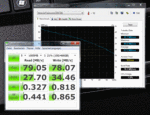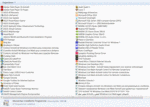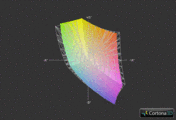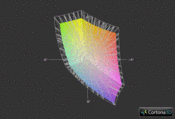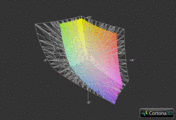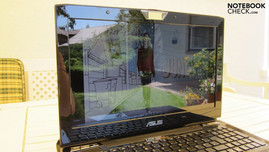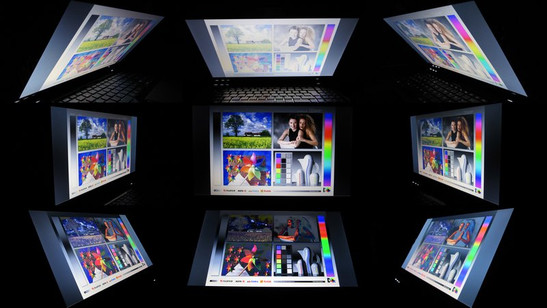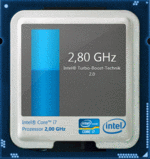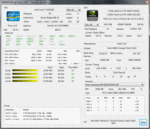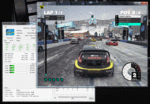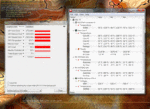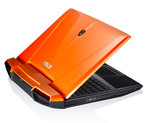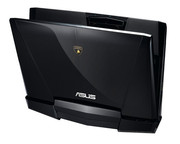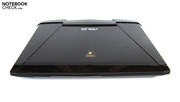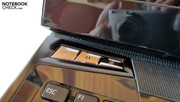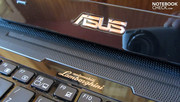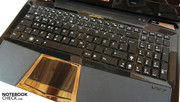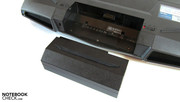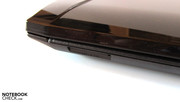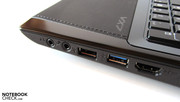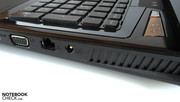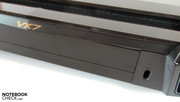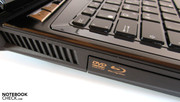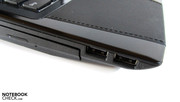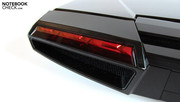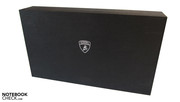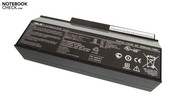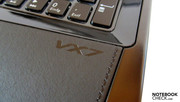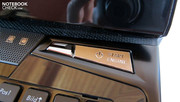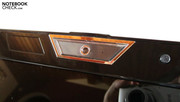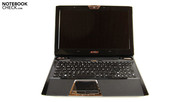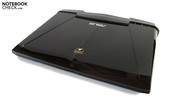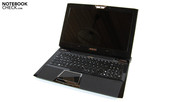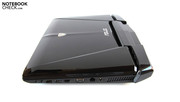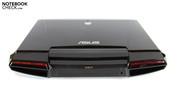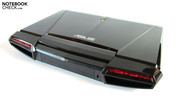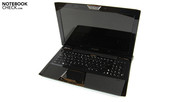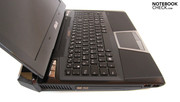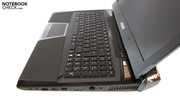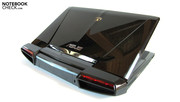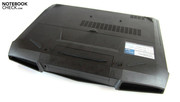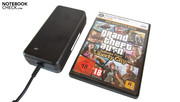Review Asus VX7 Lamborghini Notebook
In addition to the aggressive design, the high price will likely be one of the first things about the VX7 that hit the potential buyer. Asus demands a steep 2000 euros for its 15 inch gaming notebook - that is about 500 euros more than a comparably configured alternative of its more basic brother, G53. The enormous price can't just only be due to the components, anyway. Although Asus installs strong, high-end hardware, there are equally fast notebooks already found for a bit more than 1000 euros (for example, see the Medion Erazer X6813). Asus is likely reckoning on finding enough solvent customers with the "Lamborghini" effect.
But that's enough speculation. Let's rather have a quick look at the most important configuration features. Currently, there are only two VX7 models available that also have exactly the same components. First, the orange VX-SZ083V and then the VX7-SZ062V that we have in for review. Unsurprisingly, Asus has opted for a lightning fast quad core processor from Intel. The Core i7-2630QM is very popular among laptop manufacturers at the moment. Meanwhile, Nvidia's DirectX 11 capable, but no longer quite new, GeForce GTX 460M is used as the graphics card (the predecessor of the GTX 560M, which has been released in the meantime).
Unfortunately, the user has to live without a modern SSD hard disk. Asus installs two HDDs with 750 GBs each. Speaking of big: The manufacturer has grossly exaggerated in terms of main memory. A 16 GB DDR3 RAM will likely first start to get necessary in a few years. In return, the choice for the optical drive is praiseworthy. A BluRay player (burns CDs & DVDs) perfectly fits to the glossy Full HD display (1920x1080). The operating system is - how could it be otherwise - the 64 bit version of Windows 7 Home Premium.
Case
Asus has come up with quite a few ideas in terms of the VX7's design. The streamlined, black case has been inspired by Lamborghini's Gallardo and Lamborghini's Murciélago, according to the manufacturer. You especially notice the visible likeness to the super sports car when looking at the rear. The vents are emblazoned with imitation taillights placed above them. Small details, such as the "Start Engine" labeled power button, the Lamborghini logo on the dipslay lid or the engine roar during the startup (can be disabled in the BIOS), show that Asus has very well ventured into the subject thoroughly.
The notebook can't quite meet the claim of luxury in terms of materials. Thus, the wrist-rest is covered with fine leather, but the other surfaces are made only of simple plastic. Aluminum surfaces, as we've come to expect from Alienware notebooks, would have greatly increased the quality impression. If you put value on a clean device, you will likely be deterred by the sensitive high-gloss finish, as well. Keyboard (area), notebook lid and display bezel smudge very fast. Fingerprints are all over within a very short time. The workmanship also leaves room for complaint. For one thing, our test device's hinge squeaked and for another, the keyboard wasn't perfectly fitted and partly protruded slightly.
On the other hand, there isn't anything to complain about in regard to stability. The base unit could neither be visibly bent on the top nor on the bottom. Merely the lid proved to be fairly unstable. Finally, the hinges do a perfect job. The base unit doesn't lift when the lid is opened. Beyond that, surface vibrations don't provoke violent shaking of the screen.
Connectivity
Considering that the VX7 is a genuine gaming notebook, the connectivity is rather disappointing. You look for an ExpressCard slot just as much in vain as for a Firewire or eSATA port. Solely one USB 3.0 port is also a bit scanty in the high-end sector. It could have been two 3.0 ports for a price of 2000 euros.
To add insult to injury, the existing interfaces are organized very unfavorably. Most connections are placed so far front that the use of a mouse is linked to major restrictions. The lateral elbowroom suffers considerably.
Communication
In contrast, Asus does nothing wrong in terms of communication. The VX7 has a RJ45 Gigabit LAN port and supports WLAN b/g/n and Bluetooth 3.0 thanks to the wireless module.
Software
Asus show no mercy in software installation. The laptop almost bursts with bloatware - nearly 70 programs rampage on our test device. The VX7 responds accordingly slow especially after the system start. The user should take a bit of time and rid the system of superfluous ballast. The Internet usually clarifies if a program is important or not.
Scope of Delivery
Your eyes will likely beam when you have the VX7's packaging in front of you. Asus delivers its 15 incher in a classy, stable and matt black box. The notebook is enveloped in a soft textile cover - greetings from Alienware (see the M11x R3 among others). Asus additionally adds a fat 8 cell battery and a voluminous 150 watt power adapter. The bundle is finished off with a few information booklets and a driver & tool DVD.
Warranty
Asus grants customers a warranty period of two years. The warranty only applies for one year on the battery.
Input Devices
Keyboard
The keyboard makes a rather mixed impression. The successful layout, the presence of a dedicated number pad and the chiclet design (separated keys) would be mentioned on the pro side. On top of that, the VX7 can be used even in total darkness without problems thanks to the white illumination.
However, the spongy typing feel is on the con side, just like the fairly unclear pressure point and stroke. The somewhat cheap sounding typing noise joins in on that. Meanwhile, a key size of 14x14 millimeters is acceptable.
Touchpad
To bestow the touchpad with a high-gloss surface is - to put it mildly - a suboptimal decision, in our opinion. The fingers actually stick on the touchpad and the gliding traits are quite bad.
Otherwise, the well-sized touchpad of 70x43 millimeters can be disabled and shows a good performance. Most inputs are implemented precisely and reliably, no matter if the horizontal or vertical scroll bars or the various gestures are used. Multi-touch support is another bonus point.
Display
The 15.6 inch glare dispaly has an LED backlit display, an aspect ratio of 16:9 and a Full HD resolution. 1920x1080 pixels are slowly but surely becoming standard in the gaming field. Nvidia's GeForce GTX 460M is strong enough for Full HD in most games. If required, the resolution has to be reduced a bit.
| |||||||||||||||||||||||||
Brightness Distribution: 85 %
Center on Battery: 227 cd/m²
Contrast: 164:1 (Black: 1.38 cd/m²)60.1% AdobeRGB 1998 (Argyll 2.2.0 3D)
86.4% sRGB (Argyll 2.2.0 3D)
58.1% Display P3 (Argyll 2.2.0 3D)
You would actually expect an outstanding display in a 2000 euro laptop. But far from it: Asus gives the VX7 an ordinary, run of the mill screen that can't reach a reference level in any way. The black value is quite high with 1.38 cd/m2. Dark areas clearly produce a gray cast - saturated black looks different.
The contrast of 164:1 is also not worth mentioning. Good screens easily pass the mark of 500:1 (see the Schenker XMG P501 PRO, for example). On the other hand, the luminosity (average: 231.4 cd/m2) and illumination (85%) don't need to hide. Subjectively, the display is acceptable in terms of colors. As usual, it's just enough for the sRGB color spectrum.
As expected, the vertical viewing angles are pretty narrow. The image falsifies quickly especially when looking up from a lower corner. Although the viewing angles are better on the horizontal plane, the screen has to occasionally be readjusted. Overall, the inferior screen (AU Optronics B156HW01 V5) costs many points. The picture quality stays far behind the high-end claim. Asus should urgently make improvements here to justify the steep retail price.
Performance
Processor: Intel Core i7-2630QM
Asus treats the VX7 to a quad core processor from Intel's latest Sandy Bridge generation so that the graphics card isn't slowed down in games. The Core i7-2630QM normally runs with 2.00 GHz, but can be overclocked to 2.90 GHz when need be thanks to the Turbo Boost function. Beyond that, a few applications benefit from the Hyper Threading technology which simulates a virtual core to every physical core.
Six MB of L3 cache and 995 million transistors are further guarantees for excellent performance. By the way, the graphics chip called HD Graphics 3000 isn't enabled. Asus only relies on the dedicated Nvidia GPU. As all other Sandy Bridge CPUs, the Core i7-2630QM is manufactured in a state of the art 32 nm process. The thermal design power is 45 watts (35 watts in the "normal" dual cores).
CPU Performance
The CPU performance can be compared best with Cinebench R10 64 bit. The i7-2630QM easily surpasses its dual core relatives in multi core rendering. The currently fastest mobile dual core, Intel's i7-2620M (Dell Vostro 3550), places itself behind the i7-2630QM by a whole 32% (16665 points). Contrarily, the i7-2630QM falls behind in single core rendering. 4583 to 5446 points are a disadvantage of 16%. One thing is clear anyway: The future definitely belongs to the quad cores. An increasing number of games appreciate a third or fourth processor core.
Graphics Card: Nvidia GeForce GTX 460M
Demanding gamers are first contented with a graphics card from the high-end sector. The GeForce GTX 460M installed into the Asus VX7 represents the gateway to the top notch models. Nvidia's GF 106 chip provides the basis. It is a relative of the DirectX 11 capable Fermi architecture.
The GeForce GTS 460M's specs are still impressive in 2011. Starting with a large 1536 MB GDDR5 video memory (1250 MHz), which has a 192 bit wide bus. The shader count of 192 is also impressive. In contrast to the successor, GTX 560M, the clock rates are somewhat lower. The GTX 460M "only" clocks with 675/1350 MHz instead of 775/1550 MHz (core/shader).
Nvidia can primarily stand out from its main competitor, AMD, with its feature domination. Although AMD graphics cards can also decode high definition videos, Nvidia clearly has the lead when it comes to physics acceleration or stereoscopic 3D reproduction with PhysX and 3D Vision.
GPU Performance
We would like to limit ourselves to the DirectX 11 performance in the graphics benchmarks. The GeForce GTX 460M looked good in the processing intensive benchmark, Unigine Heaven 2.1. The frame rate settled to 23.5 fps in high details and 1280x1024 pixels. The MSI GT780R equipped with the newer GeForce GTX 560M achieved smoother 27.6 fps (+17%) in the same test. The performance difference is a bit smaller in the latest 3DMark 11 (1280x720). While the Asus VX7 can present a GPU score of 1617, the MSI GT780R achieved 1820 points (+13%).
| 3DMark 03 Standard | 35451 points | |
| 3DMark 05 Standard | 21632 points | |
| 3DMark 06 Standard Score | 13986 points | |
| 3DMark Vantage P Result | 8059 points | |
| 3DMark 11 Performance | 1800 points | |
Help | ||
HDD Performance
The gaming laptop truly doesn't lack memory capacity. Asus has opted for two HDDs from Seagate (ST9750420AS), which both have a capacity of 750 GB and run with 7200 rpm. The given performance is quite good for HDD conditions. The tool, HDTune, recorded an average transfer rate of 92.5 MB/s and an access time of 15 ms. The tester would have preferred a cutting edge SSD drive personally, though. Solid state drives are superior to conventional HDDs in almost every respect.
Performance Verdict
The Asus VX7 supplies enough power to fuel most programs adequately. Especially, the quad core CPU is a real powerhouse. Intel's Core i7-2630QM not only scores with an efficient architecture, but also with nice features such as dynamic overclocking. Although the GeForce GTX 460M's performance hardly leaves room for complaint, we would recommend Asus to upgrade to the stronger GeForce GTX 560M as soon as possible.
| PCMark Vantage Result | 8675 points | |
Help | ||
CPU Throttling
Before we get to the gaming benchmarks, we would like to draw attention to a serious problem. In two of the four tested games (Call of Duty: Black Ops & Dirt 3), Intel's Core i7-2630QM temporarily clocked down to only 800 MHz. Throttling was partly expressed by the image freezing for a second. The tracks were ultimately unplayable.
That the processor clocks itself down in practical applications is something we otherwise hardly ever experience. Acer's new Timeline X series recently was noticed negatively in this respect (see the Aspire 5830TG, among others). We can't say why just these two games were affected and all other benchmarks were finished as expected with certainty. The processor temperature always was within an absolutely healthy range, the energy saving plan "high performance" was set correctly and there weren't any options in the BIOS that would explain this issue, either. We even tried a different graphics driver (267.21 instead of 266.43). Result: no change.
The CPU throttling is penalized with a reduction of 4% in the personal rating (=impression) for now. We can only hope that our test model is a "lemon device" or, if several devices are affected, that Asus will solve the problem fast. Perhaps we will order a second VX7 for review.
Update: Throttling could be prevented with the freeware tool "Throttlestop". The benchmarks have been adjusted accordingly.
Crysis 2
Crysis, a first person shooter, developed in Germany, unrelentingly shows the GeForce 460M its limits. Our test sequence stuttered very heavily when using 1920x1080 pixels and the preset "Extreme" (17.8 fps). The GeForce GTX 560M copes a bit better with these settings. The Schenker XMG P501 PRO settled to 20.1 fps. In return, the setting "Very High" and a resolution of 1366x768 don't overtax the VX7. You can prowl through the battered streets of New York wonderfully with almost 60 fps.
| Crysis 2 | |||
| Resolution | Settings | Value | |
| 1920x1080 | Extreme | 17.8 fps | |
| 1366x768 | Very High | 51.4 fps | |
| 1024x768 | High | 70.8 fps | |
| 800x600 | High | 102.9 fps | |
Call of Duty: Black Ops
As already mentioned, Black Ops causes the CPU to downclock. You can clearly recognize the considerable cave-ins of the refresh rate in the performance diagram. The first person shooter occasionally stuttered along with less than 20 fps. Normally, the GeForce GTX 460M is fast enough for 1920x1080 pixels, quadruple antialiasing, octuple anisotropic filtering and "Extra" details. An average of 45.6 fps is a good result. The frame rate increased to 56.5 fps with Throttlestop.
| Call of Duty: Black Ops | |||
| Resolution | Settings | Value | |
| 1920x1080 | extra, 4xAA, 8xAF | 56.5 fps | |
Fifa 11
Technically less demanding games, such as Fifa 11, can't impress the GeForce GTX 460M at all. The soccer simulator is rendered as smooth as silk even in high details, quadruple antialiasing and a resolution of 1920x1080. 133 fps speak for themselves. The GeForce GTX 560M at least calculates faster on paper. The MSI GT780R achieved 151.9 fps.
| Fifa 11 | |||
| Resolution | Settings | Value | |
| 1920x1080 | high, 4xAA, 0xAF | 133 fps | |
Verdict: Gaming Performance
All in all, Nvidia's GeForce GTX 460M can be called a successful graphics card. The majority of current tracks can even be played in high details. The reserves are often even enough for image enhancements, such as antialiasing. The resolution plays an important role here. While 1600x900 pixels, for example, get along perfectly with the GTX 460M, the graphics card occasionally found its limits in higher resolutions.
As we have presented in the review of the MSI GT780R, the successor GTX 560M basically performs over 10% faster - a measurable, but not world shattering, difference. Gamers, who want to enjoy every track in the maximum details and resolutions should rather look out for a laptop with a Radeon HD 6970M or GeForce GTX 580M.
| low | med. | high | ultra | |
|---|---|---|---|---|
| Fifa 11 (2010) | 133 | |||
| Call of Duty: Black Ops (2010) | 56.5 | |||
| Crysis 2 (2011) | 102.9 | 70.8 | 51.4 | 17.8 |
| Dirt 3 (2011) | 189.4 | 108 | 73.6 |
Emissions
System Noise
In addition to the high performance, the moderate noise development is one of the VX7's biggest strengths. When the laptop is faced with a low load, e.g. by means of a video file, you can only hear a quiet whirr. The fan doesn't turn up excessively in gaming mode. The user can completely concentrate on the game. The VX7 is far from an annoyingly loud level even during full load (which is likely also due to the CPU throttling).
We basically experienced the fan noise as pleasant. Constant speed changes, as is known from other devices, are an unknown issue for the VX7. Even the optical drive proved to be fairly quiet over long periods. The hard disks couldn't be heard at all to begin with. Thus, noise sensitive users don't have to hesitate. The majority of high-end notebooks work noticeably louder especially during load.
Noise Level
| Idle |
| 33.4 / 33.6 / 35.2 dB(A) |
| DVD |
| 34.6 / dB(A) |
| Load |
| 38 / 41.2 dB(A) |
 | ||
30 dB silent 40 dB(A) audible 50 dB(A) loud |
||
min: | ||
Temperature
You needn't fear hot fingers when using the VX7. All surfaces stay agreeably cool in idle mode. Around 28°C stand for a comfortable work environment. The bottom heats up in particular during load. We could measure up to 49°C in the rear area. Using the notebook on the lap while gaming is thus not a good idea. The top doesn't get quite as warm during load. A maximum of 37°C is more or less acceptable. The wrist-rest shows itself rather unimpressed on the other hand. A typing marathon of several hours can be easily realized.
Merely Nvidia's GeForce GTX 460M works up quite a sweat under the hood. Intel's Core i7-2630QM downclocked to a meager 800 MHz immediately as the tools Furmark and Prime were enabled at the same time and stayed in an accordingly cool range. However, the graphic card's temperature increased up to 93°C - a very high, but still just reasonable rate.
(+) The maximum temperature on the upper side is 37 °C / 99 F, compared to the average of 40.5 °C / 105 F, ranging from 21.2 to 68.8 °C for the class Gaming.
(-) The bottom heats up to a maximum of 48.5 °C / 119 F, compared to the average of 43.3 °C / 110 F
(+) In idle usage, the average temperature for the upper side is 27.8 °C / 82 F, compared to the device average of 33.9 °C / 93 F.
(+) The palmrests and touchpad are cooler than skin temperature with a maximum of 30.4 °C / 86.7 F and are therefore cool to the touch.
(±) The average temperature of the palmrest area of similar devices was 28.9 °C / 84 F (-1.5 °C / -2.7 F).
Speakers
The VX7's sound quality doesn't go beyond a mainstream level. The sound of both speakers, installed above the keyboard, lacks precision, volume and fidelity as typical for notebooks. The maximum volume is pretty disappointing. You should sit directly in front of the laptop during movies, music tracks or games. Since there is no subwoofer, a real bass sound doesn't develop. In short: We would definitely recommend using external speakers.
The THX application control (it is THX TruStudio supported) should be set carefully, by the way. If you set the control too far left, you will experience a dampened and hollow sound. In contrast, when the option is turned up to full, the sound gets too high and tends to fray.
Battery Life
The 15 incher proves to be inconspicuous in terms of power consumption. 23.1 to 29.8 watts in idle mode and 142.6 to 146.7 watts during load are normal in the high-end sector. The comparably equipped Medion Erazer X6813 proved to have similar average rates - especially in idle mode.
| Off / Standby | |
| Idle | |
| Load |
|
Key:
min: | |
The battery life won't likely knock anyone off their socks. It's only enough for the midfield since the VX7 has to cope without Nvidia's Optimus technology. The strong components simply take their toll. The included 8 cell battery (74 Wh, 5200 mAh) can't really develop its potential.
Naturally, the runtime is still best in idle mode (simulated by BatteryEater's Classic Test). The 15 incher could achieve 3.5 hours in minimum brightness and maximum energy saving options. On the other hand, the display turns black after about two hours and 20 minutes in practical web surfing via WLAN, or rendering a DVD (maximum brightness & medium energy saving options).
The VX7 doesn't need an outlet for an above average period during load. It lasted for one hour and 41 minutes in BatteryEater's Classic Test (maximum brightness & disabled energy options). Many gaming laptops are drained after well an hour during load. The VX 7 isn't suitable as a travelling companion, anyway. The high weight (almost 3.8 kilograms) and the glossy display limit the possibilities considerably. The 15 incher has primarily been designed for stationary use.
Verdict
Asus has set itself an ambitious goal in the development of the VX7: the 15 incher was to become a high performance gaming notebook in an dynamic Lamborghini design with lavish innards. The manufacturer has doubtlessly reached these goals. The high-end components bid a lot of power, both hard disks (1.5 TB total capacity) even store large amounts of data, the BluRay drive gives the VX7 multimedia character.
The extravagant design is definitely a matter of taste, but the courage to stand out has earned a some respect, though. However, the nearly six centimeter high case does prove to have various weaknesses in detail. For example, there is the (smudge) sensitive high-gloss surface and the adverse interface positioning. In addition, smaller manufacturing flaws, such as the squeaky hinge or the slightly protruding keyboard, join in.
Generally, the input devices aren't one of the 15 incher's strengths. We found the keyboard's typing characteristic quite spongy. The touchpad annoyed with modest gliding traits. Image and sound quality are also remote from a very good rating. In particular, the screen isn't worthy for a high-end laptop.
Meanwhile, the biggest problem of our test device was the massive CPU throttling. The fact that the processor partly even downclocks during games is an absolute no-go. The moderate temperature, respectively noise development can only help alleviate this flaw to a certain extent.
Overall, we consider the retail price far too high. Asus shouldn't demand more than 1400 euros for its gamer. The list of complaints is long, thus the VX7 doesn't receive a purchase recommendation. There are cheaper, better and more developed 15 inch alternatives available, such as the XMG P501 PRO from Schenker Notebooks.






